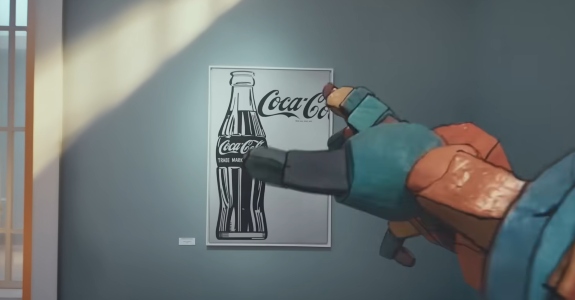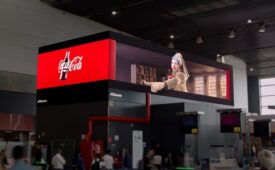Product design: evolution and future in the midst of AI
Amanda Snyder
31 July 2023 – 6:00
When consuming a simple can of Coca-Cola, people often do not stop to think about how this product was created and how the design was developed. Although it seems that it has always been this way, almost all products that are part of everyday life were considered and projected by a product designer, as a certain way.
The discipline of product design focuses precisely on the creation and development of objects for consumption by the population, be they utensils, appliances, furniture or even automobiles. These products must be related to solving the problems of these consumers.

Coca-Cola launched an AI-assisted campaign this year (Credit: Reproduction)
“Product design, and more specifically packaging design, is the maxim ‘form follows function’ is more present than the concept of the industry. This function must always start from a consumer need,” adds Coca-Cola Latam design director Camila Moletta.
Camila reveals that in the late 19th century, Coca Cola began to be sold in bottles so that customers could take the drink home and consume it whenever they wanted. Until then, the drink was only sold in open glasses directly in commercial establishments. “Form follows function and creates a change in behavior,” reinforces the designer.
Over the years and with technological development, the discipline of product design has acquired more and more tools to help it develop products faster and at scale, physically or digitally.
According to Leticia Pettená, co-founder of brand consultancy Marcas com Sal, today product designers have more awareness and tools to study the user and, based on that, create. “When we think specifically about digital products, that changes everything. The usability of the interface can become the competitive advantage of the business.”
In this context of technological development, artificial intelligence emerged and, with it, transformed the discipline of product design. Levi Girardi, CEO and co-founder of Questtonó, a design and innovation consultancy, points out that AI is, in fact, an evolution of the digital tools that design professionals have come to have over the past 20 years.

The future of design and artificial intelligence
“In the old days, you drew using a sketch pad, paper and pen. Over time, you started having access to computer-aided design tools and things evolved,” he adds. Increasingly, in a linear curve, digital tools have aided the entire design process, including collaborative projects, according to Girardi.
In the opinion of the president of the Brazilian Association of Design Companies (ABEDESIGN), Gabriel Lopes, technology should be seen as a great tool, an accelerator of time. “I see technology as a great ally of the designer or any professional as an accelerator of time,” he adds.
Still, the boom in productive AI, fueled in large part by the ChatGPT boom, has brought with it concern on the part of some professionals in the field. This is because the questioning of the replacement of humans by AI was present in almost all discussions on the subject.
AI as an accelerator
However, the CEO of Questtonó emphasizes that the trend is for artificial intelligence for product design to facilitate and speed up the process for what the professional does not need to spend so much time, so that he can take advantage of that time with what creates value and differentiation. about the project. Leticia, co-founder of Marcas com Sal, agrees with Girardi: “I like to think of AI tools as an accelerator of the less creative tasks in the process. It is a principle that will later be perfected.’
Camila, from Coca-Cola, also has an optimistic view on the impact of artificial intelligence on product design. For her, currently, there are more opportunities than challenges in using artificial intelligence for product development. “It’s time to experiment and learn,” he says.
In March of the same year, Coca-Cola created an AI platform together with OpenAI and Bain & Company called “Create Real Magic”. By design, the idea was for people to use the platform with their archival visuals to create new art using ChatGPT-4. The new art created was displayed on one of the largest billboards in the world, in London’s Piccadilly Circus.
In the same month, the company also launched its global ‘Obra de Arte’ campaign, which combined world-renowned artworks with works by emerging artists from around the world, incorporating cutting-edge artificial intelligence. The film (see below) and campaign content were created by Blitzworks.
Still, the Coca-Cola designer believes this is just the beginning of what will be possible with artificial intelligence. “Being able to rely on a collective intelligence and build solutions that weren’t possible before, here I’m thinking about personalization, smart use of materials, impact at the point of sale, renaissance, that’s coming in the next five years,” he emphasizes. .
Leticia, from Marcas com Sal, highlights other opportunities in the area, such as user studies, using Bard or ChatGPT to create research questionnaires and support sample identification. or even as part of the creation itself, where you can think along with the machine, seeing how it wouldn’t start from scratch, as well as in the design experimentation phase. “With tools like MidJourney, the part of implementing a product in a context is simpler,” he explains.

The Coca-Cola action allows you to remove the drink from the 3D painting
Challenges in the design + artificial intelligence relationship
In Leticia’s view, the challenges are related to training the teams on tools, writing prompts and using them in a smart way. “We can’t just automate the whole process, because we’d probably be pasteurizing the results.” According to her, it is necessary to have a good dose of sensitivity to reach authenticity, which tools do not have.
Time for human beings to learn the tools is the big challenge of using artificial intelligence in design, according to ABEDESIGN’s Lopes. “When we talk about innovation and technology, we talk about time, we say that the time of application of technology is the most important thing in this relationship between any application.” In this sense, López points out that if the professional does not want to be replaced by a robot, he should not act like one. “You have to continue with critical thinking,” he adds.
Another challenge, for the co-founder of Marcas com Sal, is that many digital products will no longer have visual interfaces and will become conversational. In his view, this changes the dynamic of design and the professional profile required for this type of creation.
#Product #design #evolution #future #midst